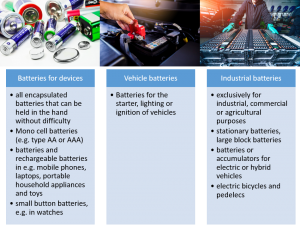The global demand for batteries is constantly increasing, and with it the need for raw materials for battery production. At the same time, many batteries are disposed of at the end of their life cycle and the recovery of valuable raw materials is becoming increasingly important. What contribution can batteries make to a more sustainable economy, and how can the battery industry itself be made more sustainable?
Why do we need batteries?
With primary batteries and accumulators (rechargeable batteries, secondary batteries), hereafter summarised under the term batteries, chemical energy (electric current) can be stored and made available when needed. Well-known examples are rechargeable batteries in laptops and mobile phones or batteries in torches. The global demand for batteries has increased enormously in the last decade due to the development of electromobility and renewable energy generation and the associated need to store solar and wind energy. It is assumed that the demand for batteries, especially lithium-ion batteries, will increase more than tenfold by the end of this decade [1].
What kind of batteries are available?
The smallest battery has the dimensions of a grain of salt, the largest are combined in battery storage power plants as high as a house. There are therefore different subdivisions for batteries. For example, batteries are called primary batteries if they cannot be recharged after they have been discharged. Accumulators, on the other hand, are rechargeable batteries, so-called secondary batteries.
A further distinction is made between portable batteries, automotive batteries and industrial batteries (see infobox).

Furthermore, a distinction can be made between solid-state batteries and liquid electrolyte batteries (“wet cell”). In solid-state batteries, both electrodes and the electrolyte are present as solid material. These batteries are still under development. In contrast, the electrolytes of liquid batteries are in dissolved form and have been used for many years. Lithium-ion batteries, for example, which are currently the most widely used batteries, belong to the category of liquid batteries.
Batteries on the way to more sustainability
 Secondary batteries/accumulators are a key technology for the transition to a circular economy. They enable the storage of renewable energies and thus promoting the transition to low-emission electromobility. However, this can only succeed if the batteries themselves are also produced in a way that minimises the impact on humans and the environment. Here, in addition to the use phase, the production phase is also being intensively considered. To this end, all materials used for the production of batteries must be obtained and produced according to social and ecological standards. It is also necessary that the recycling rate is increased in order to minimise the impact on the environment during disposal on the one hand and to reduce the demand for raw materials on the other. Many of the raw materials used have so far been extracted under poor social conditions (e.g. through child labour). The aim should be to respect the human rights of all people involved in battery production in the future. Therefore, it is a challenge to produce batteries in a sustainable way [1].
Secondary batteries/accumulators are a key technology for the transition to a circular economy. They enable the storage of renewable energies and thus promoting the transition to low-emission electromobility. However, this can only succeed if the batteries themselves are also produced in a way that minimises the impact on humans and the environment. Here, in addition to the use phase, the production phase is also being intensively considered. To this end, all materials used for the production of batteries must be obtained and produced according to social and ecological standards. It is also necessary that the recycling rate is increased in order to minimise the impact on the environment during disposal on the one hand and to reduce the demand for raw materials on the other. Many of the raw materials used have so far been extracted under poor social conditions (e.g. through child labour). The aim should be to respect the human rights of all people involved in battery production in the future. Therefore, it is a challenge to produce batteries in a sustainable way [1].
The basis for this is provided by the UN’s sustainability goals (see also basic text on sustainability). Likewise, batteries must be efficient and safe over their entire life cycle. Batteries should make an important contribution to achieving the goal of climate neutrality by 2050 set out in the European Green Deal [2]. Therefore, there are now many activities at European level to anchor the sustainability requirements for batteries in regulations. The aim is to establish a circular economy for battery raw materials and components in Europe. The draft of the new EU Battery Regulation is of crucial importance for the creation of a competitive, sustainable and circular battery value chain in Europe. In addition to transparent information on greenhouse gas emissions from the manufacturing process, the battery regulation also formulates, among other things, minimum requirements for the durability and performance of batteries as well as a minimum content of recycled raw materials [3,4].

For example, it is envisaged that collection targets of 45% by 2023, 63% by 2027 and 73% by 2030 will be achieved for portable batteries. For reuse in new batteries, minimum quantities have been set for cobalt (16%), lead (85%), lithium (6%) and nickel (6%), which need to be recovered from production and consumer waste.
Safety of batteries
The safety assessment of batteries is an important part of the sustainability assessment and can be done on two levels. On the one hand, the complete battery is considered, and its behaviour in the event of accidents or damage (exposure to fire, risk of explosion). Solid-state batteries, for example, are expected to offer great safety advantages and at the same time higher performance.
The second level is to look at the safety of individual materials relevant to battery production (e.g. cobalt) and their impact on humans and the environment. This is relevant for occupational safety or in the assessment of a possible release of pollutants into the environment.
How can battery sustainability be measured?
But how can a manufacturer or consumer check whether a battery is sustainable? A number of indicators have been developed for this purpose, which also enable the comparison of different batteries with regard to their sustainability. Not all of these indicators are already used in battery production. The draft of the new EU Battery Regulation (BattVO-E) names a number of indicators that are to be used for the sustainability assessment of batteries.
Indicators for the sustainability of batteries [1,4]:
Environmental impact: Indicators to describe the environmental impact are available, for example for water consumption or greenhouse gas emissions. They are already applied in many areas, even outside the battery industry, and can therefore be considered practicable. Concrete application in battery cell production is foreseen in the draft of the new EU Battery Regulation and will thus become mandatory (e.g. for the CO2 footprint).
Circular economy & end-of-life management (disposal and recycling): Indicators on circular economy and end-of-life management are available, for example for recycling efficiencies or recovery rates for secondary raw materials. Since some of these will only be applied in future regulations, their practical suitability for batteries still needs to be tested. A comparative look at the Chinese recycling industry shows that a large number of measures to regulate the circular economy and end-of-life management have also been adopted there. The indicators used there, such as material recovery rates, are in part similarly ambitious to those in the draft EU Battery Regulation.
Social issues & human rights: Indicators on social issues and human rights are available and are not sector-specific, e.g. child or forced labour and occupational safety. They are considered practical, but some indicators, for example the forced labour indicator, are difficult to collect in practice as no transparent figures are available on this.
Working conditions: Indicators on working conditions are available and are not sector-specific, e.g. on fair wages and working hours. They are widely used in practice and are already frequently applied.
Further information
- Measuring sustainability: A consistent metric for sustainable batteries. VDI/VDE Innovation + Technik GmbH 2022. https://www.ipcei-batteries.eu/fileadmin/Files/accompanying-research/media/download/2022-01-BZF_Nachhaltigkeitsmetrik-ENG.pdf
- A European Green Deal. Striving to be the first climate-neutral continent. https://commission.europa.eu/strategy-and-policy/priorities-2019-2024/european-green-deal_en
- European Commission (2020). Proposal for a REGULATION OF THE EUROPEAN PARLIAMENT AND OF THE COUNCIL concerning batteries and waste batteries, repealing Directive 2006/66/EC and amending Regulation (EU) No 2019/1020, COM/2020/798 final, https://eur-lex.europa.eu/legal-content/EN/TXT/?uri=CELEX%3A52020PC0798
- EU Commission. Environment. Batteries. https://environment.ec.europa.eu/topics/waste-and-recycling/batteries_en
 >
>